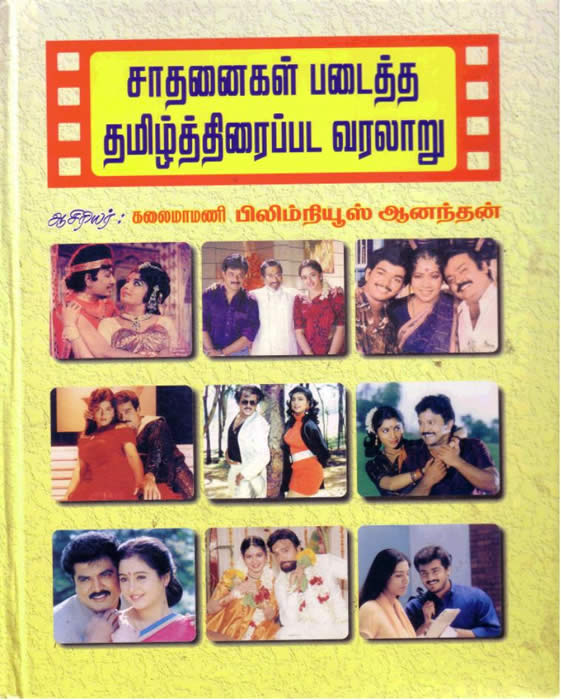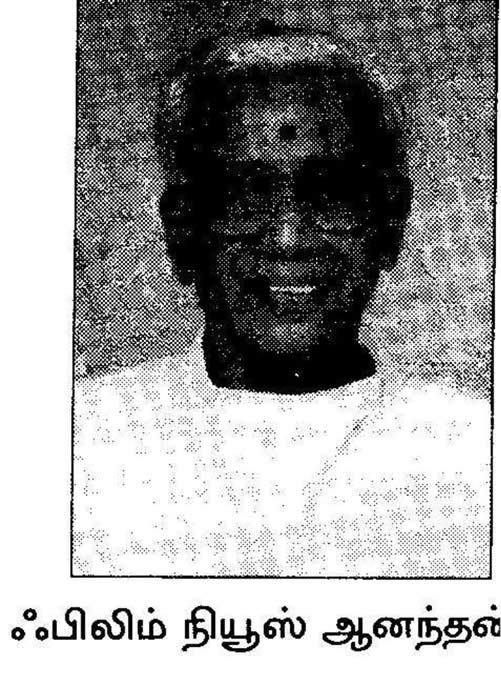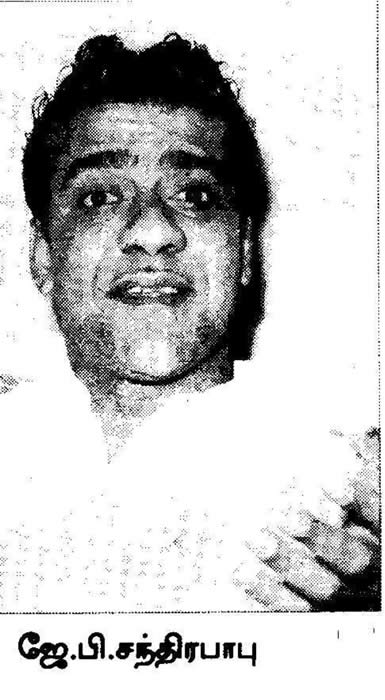
SANGAM.ORG
Ilankai Tamil Sangam, USA, Inc.
Association of Tamils of Sri Lanka in the USA
by Sachi Sri Kantha
Sadhanaigal Padaitha Thamizh Thiraipada Varalaru (Tamil Fim History and Its Achievements) – in Tamil, edited by Kalaimamani ‘Film News’ Anandan, Sivagami Publications, Chennai, Sept.2004, 738 pp, 500 Indian Rupees.

Many may remember their very first visit to a movie theater during their innocent childhood days, in the company of their parents and elder siblings. I do. My first movie-watching experience was in Eelam’s Mullaitivu town in 1958. Like the faded movie posters, the name of the theater has faded from my memories now. It might have been a ‘tent’ theater. Also lost in my memories was the story line of the movie I saw then.
But, I haven’t forgotten one particular scene and the first movie song which thrilled me. The hero Gemini Ganesan (1920-2005) was driving a car. A young boy was his companion in that car. The hero was lip-synching a sweet melody sung by renowned Telugu composer and playback singer Ghantasala Venkateswara Rao (1923-1974). The song carved in my memory was, ‘Suya nalam peritha – Pothu na lam peritha; Intha sollin unmai thannai enni paarada’ [Is a selfish spirit big? Or is the civil spirit big? Just think on the truth of my words]. The lines of that gifted lyricist A. Marudakasi's (1920-1989) song seem so timeless. That movie which enthralled me as a boy was captivatingly named, ‘Yaar Paiyan’ [Whose Boy?].
lam peritha; Intha sollin unmai thannai enni paarada’ [Is a selfish spirit big? Or is the civil spirit big? Just think on the truth of my words]. The lines of that gifted lyricist A. Marudakasi's (1920-1989) song seem so timeless. That movie which enthralled me as a boy was captivatingly named, ‘Yaar Paiyan’ [Whose Boy?].
For years, I have wanted to know more on the details and individuals who were associated with the first movie I saw - Yaar Paiyan. But I didn’t know where to check. Has there been a source book on facts on Tamil movies? None, until the book in review, compiled by ‘Film News’ Anandan, appeared in late 2004. This is a one of a kind of book. I can assure this because I have been searching for such a source book on Tamil movies in either Tamil or English for a long time. Here are the details provided for that ‘Yaar Paiyan’ movie in Anandan’s book.
Released 26-7[July]-1957; [Length] 15,600 feet; Producers - N.S.Thiraviyam and T.A.Durairaj; Director - T.R.Raghunath; Music arranger - S.Dhakshinamurthy; Lyrics – Marudakasi; Art – Ganga; Dance – Thangaraj, K.C.Reddy, A.K.rattan; Still – Tiruchy K.Arunasalam; Lab – Vijaya; Studio – Vauhini; Cast - Gemini Ganesh, Savithri, N.S.K.[rishnan], Balasaraswathi, T.R.Ramachandran, Vidyawathi, Sarangapani, P.S.Gnanam, V.K.Ramasamy, Kusalakumari, Ambika.
‘Yaar Paiyan’ was only one of the 30 ‘direct’ Tamil movies released in the year 1957. Another 13 movies released in that year were ‘dubbed’ from another Indian language. Since India is a land of multiple languages, with artists, producers and directors fluent and comfortable in working in languages other than their mother tongue, ‘dubbing’ from a sister language was a quickie method for additional revenue for the movie moguls and studios.
 This year marks the 110th anniversary of the introduction of movies into India. As per the archival data presented in the book ‘Indian Film’ (1963) by Erik Barnouw and S.Krishnaswamy, a Times of India newspaper advertisement of July 7, 1896, had invited Bombay residents to witness “living photographic pictures in life-sized reproductions” by Messers. Lumiere Brothers. This year also marks the 75th anniversary of the first release of a Tamil movie in 1931. The first Tamil movie which was produced in Bombay and released on October 31, 1931 was ‘Kalidas’, directed by H.M.Reddy. Its length was 10,000 feet. Its cast included, P.G.Venkatesan, L.V.Prasad, T.P.Rajalakshmi, Rajambal, T.Susila Devi and M.S.Santhanalakshmi.
This year marks the 110th anniversary of the introduction of movies into India. As per the archival data presented in the book ‘Indian Film’ (1963) by Erik Barnouw and S.Krishnaswamy, a Times of India newspaper advertisement of July 7, 1896, had invited Bombay residents to witness “living photographic pictures in life-sized reproductions” by Messers. Lumiere Brothers. This year also marks the 75th anniversary of the first release of a Tamil movie in 1931. The first Tamil movie which was produced in Bombay and released on October 31, 1931 was ‘Kalidas’, directed by H.M.Reddy. Its length was 10,000 feet. Its cast included, P.G.Venkatesan, L.V.Prasad, T.P.Rajalakshmi, Rajambal, T.Susila Devi and M.S.Santhanalakshmi.
From 1931 to 1942, 289 ‘direct’ Tamil movies were released, and the first ‘dubbed’ movie in Tamil was released in 1943. But in the years 2000, 2001 and 2002, the annual number of movies ‘dubbed’ from another Indian language into Tamil (95, 104 and 110 respectively) over-reached the annual number of ‘direct’ movies produced in Tamil (69, 82 and 83 respectively). Chalk this up to the convenience of computer-generated technology in all aspects of movie production. Between 1943 and 2003, a total of 1,606 ‘dubbed’ movies into Tamil had been released.
 Anandan’s compilation is a treasure of statistics on released Tamil movies until the end of 2003. Here are some interesting threads. The numbers hereafter refer to ‘direct’ movies only and not to the ‘dubbed’ movies. From 1931 to the end of 2003, a total of 4,186 movies had been released. It took 34 years (from 1931 to 1965) for the release of first 1,000 movies. Then, it took only 16 years (from 1966 to 1981) for the number to reach 2,000. At the end of 1981, the released Tamil movie count stood at 2,034. The speed accelerated further and took only an additional 9 years (from 1982 to 1990) for the number to reach 3,000. At the end of 1990, the released Tamil movie count stood at 3,023. At the end of 2002, the released Tamil movie count cumulated to 4,003. As a cynic may note, the quality of the Tamil movies - with notable exceptions- understandably showed a decrease with the increasing number of released movies.
Anandan’s compilation is a treasure of statistics on released Tamil movies until the end of 2003. Here are some interesting threads. The numbers hereafter refer to ‘direct’ movies only and not to the ‘dubbed’ movies. From 1931 to the end of 2003, a total of 4,186 movies had been released. It took 34 years (from 1931 to 1965) for the release of first 1,000 movies. Then, it took only 16 years (from 1966 to 1981) for the number to reach 2,000. At the end of 1981, the released Tamil movie count stood at 2,034. The speed accelerated further and took only an additional 9 years (from 1982 to 1990) for the number to reach 3,000. At the end of 1990, the released Tamil movie count stood at 3,023. At the end of 2002, the released Tamil movie count cumulated to 4,003. As a cynic may note, the quality of the Tamil movies - with notable exceptions- understandably showed a decrease with the increasing number of released movies.
In my view, like humans, any institutions (such as cities, industries, buildings and political parties), infrastructures and productions created by humans also inevitably show aging. And the Tamil movie industry cannot be an exception. If the ‘salad days’ of humans are liberally equated to the span between 15 and 40 years, the same 25 year period of the Tamil movie history falls between the years 1945 and 1970. Thus, it may not be an exaggeration to allude that the best quality Tamil movies spanning all genres – mythologicals, musicals, historical costume dramas, social melodramas and comedies – appeared during these ‘salad days’ of the Tamil movie industry – the so-called ‘Golden Period’ of Tamil movies. What has passed in the last 35 years are, with occasional exceptions, either repetitive carbon copies or skillfully plagiarized models of earlier versions of Tamil movies or artfully dodging adaptations from movies produced in other languages and in Hollywood.
Another vital index revealing the senility of the Tamil movie industry is the number of studios currently in operation in Tamil Nadu. As per Anandan’s count, only seven studios (AVM, Arunachalam, Karpagam, Murugalaya, Prakash, Prasad and Vijaya-Vauhini) are open for production now. A total of 29 studios which produced Tamil movies from the mid 1930s have gone out of business; 10 in Chennai, 11 in Kodambakkam, 3 in Salem, 3 in Coimbatore and 2 in Madurai.
If I were asked to select the ten landmark Tamil movies, spanning all genres, which delighted the multitude of fans immensely, my choices (in chronological order) would be as follows: Meera (1945), Velaikkari (1949), Parasakthi (1952), Raththa Kanneer (1954), Madurai Veeran (1956), Nadodi Mannan (1958), Kalyana Parisu (1959), Pasa Malar (1961), Server Sundaram (1964) and Thillana Mohanambal (1968). Sure, there have been other landmark Tamil movies, but my emphasis is on movies ‘which delighted the multitude of fans immensely.’ My selections are primarily influenced by the contributory aspect of the movies to the elocution, music and drama components [the iyal, isai and nadagam respectively], delineated by the traditional Tamil culture.
Anandan’s book provide the details on the personalities (actors, producer with producer banner, director, music arranger, lyricist, and script writer) who collaborated in the production of these landmark movies. For the movies released up to the year 1960, the details of the acting cast are given in detail. Since 1961, only the names of two leading actors are provided and the reduction in detail is unavoidable and attributable to space limitations.
Apart from the chronological listing of Tamil movies released from 1931 to 2003, other inter-related factual tidbits provided in the book include,
(1) Novels which have been made into Tamil movies
(2) Dramas which have been transformed into Tamil movies
(3) The details of awards received by Tamil movies and the recipients of awards
(4) A synopsis of Tamil movie history
(5) Thumb-nail profiles of 212 ‘movers and shakers’ of the Tamil movie world
(6) Birthdays and months (but not years!) of personalities ofthe Tamil movie world
(7) Deathdays and months (but not years!) of personalities of the Tamil movie world
These details compliment the information presented in the available authentic source book on Indian film history, Encyclopaedia of Indian Cinema, edited by Ashish Rajadhyaksha and Paul Willemen (1999, Oxford University Press, New Delhi, New Revised edition, 1999). Even for this source book, the editors have acknowledged the contributions of ‘Film News’ Anandan on filling in the details on the information pertaining to Tamil movies and Tamil movie personalities.
Though quite a number of Ceylon-born (or Ceylon-bred) youngsters have valiantly attempted to make a grade in the Tamil movie industry since its inception, many couldn’t make it to the top. But, five names stand out prominently as polestars in the marks they set during the past seven decades. These are, M.G.Ramachandran aka MGR (1917-1987) as one of the lead heroes for 30 years; Arul Susai Anthony Sami aka A.S.A.Sami (1915-1998) as a trendy script writer-director in late 1940s and 1950s; K.Thavamani Devi (? – 2001) as the first Tamil singing-sexy starlet [a cross between Maureen O’Sullivan and Marilyn Monroe] in Tarzan and mythological genres of 1940s; J.P.Chandrababu (1932?-1974) as the ranking comedian cum singer of 1950s and early 1960s, and Benjamin Mahendra aka Balu Mahendra (1946 - ) as one of the New Wave cinematographer-directors in late 1970s and 1980s.
The birth locations of MGR, Sami, Thavamani Devi and Mahendra were Kandy, Colombo, Jaffna and Batticaloa respectively. Chandrababu was born in Thoothukudi (Tamil Nadu), but bred in Colombo. Among these notable five, MGR and Chandrababu were irreplacable talents and the void created by their departure has not been filled by any alternates. Thus, Anandan’s book is also a mine for prospective biographers on these talented artistes.
Between the 1970s and early 1990s it was fashionable among the progressive Marxist-Communist opinion makers like K.Sivathamby and M.S.S.Pandian to deride the Tamil movie material as nothing more than mere bourgeois escapist treats for the entertainment of the illiterate masses.
A contrary view of how Tamil stage/movie actors influenced the spoken language trends and became the arbiters of informal consensus has been provided by Tamil language scholar Harold Schiffman, of the University of Pennsylvania. In an interesting research study entitled ‘Standardization or restandardization: The case for Standard Spoken Tamil’ (Language in Society, 1998; vol.27, pp.359-385), Schiffman has identified one particular benefit of movies to Tamil society. This is relating to the advancement of Standard Spoken Tamil (SST) across physical barriers. I cite two paragraphs from this analysis. According to Schiffman,
“I claim that Standard Spoken Tamil [SST] also emerged via an informal decision making-process, similar to the way British RP [Received Pronunciation] and American Broadcast Standard evolved; but its emergence involved decision-making about the grammar and syntax as well as pronunciation. After a certain consensus was reached on the broad features of SST, it could become the natural choice for use in the ‘social’ film. It was thus disseminated widely to Tamil speakers everywhere, serving both as a model of ‘correct’ speech. This variety was spoken by the central chracters, the hero and heroine, while the character actors cast as buffoons and rustics provided models of ‘incorrect’ speech; the ‘Jerry Lewis’ character Nagesh was famous for this in the Tamil film, and other linguistic cultures hae their equivalents.”
Schiffman’s observation is distinctly illustrated in the dialogue presented in the popular ‘Thillana Mohanambal’ movie. While the hero and heroine characters (played by Sivaji Ganesan and Padmini) speak the standard variety, the comedian characters (Nagesh and Manorama) deliver the sub-standard variety. A third type presented in this movie was the specific niche variety spoken by the musician characters (played by T.S.Balaiah and K.A.Thangavelu). To quote Schiffman’s other related paragraph,
“In the mid-20th century, it is clear that the chief disseminator of this SST has been the modern Tamil ‘social’ film. There is remarkable uniformity of SST irrespective of whether the studios were dominated by the DMK political party or the Congress – that is, usage is similar in MGR films and Sivaji Ganesan films, to take only two examples. Despite the DMK’s public oratorical style, which emphasizes a purified, archaized, and highly alliterative Tamil, their films used SST that varied hardly at all from the kind found in other studios’ films, except when the hero expatiates in the special DMK-preferred alliterative style. This variety is also found in the stage dramas of the social variety that have a symbiotic relationship with the Tamil film industry…”
The material presented by Anandan may also help students of Tamil linguistics in deciphering the transformation of predominantly mythological plots with Brahmin-caste dialogues (from 1931 to 1948) into the contemporary social themes (from 1949 onwards) in Tamil movies. The contributions of a galaxy of movie script writers such as poet Bharathidasan, C.N.Annadurai, Elangovan, A.S.A.Sami, P.Neelakandan, B.S.Ramiah, M.Karunanidhi, poet Kannadasan, C.V.Sridhar, K.S.Gopalakrishnan, K.Balachandar and Aroordhas, who catalyzed such a change by their powerful scripts, deserve further study.
Anandan provides a statistic that Tamil Nadu has 2,540 movie theaters; and among these, 1,513 are permanent theaters and the remaining 1,027 belong to the non-permanent (tent-type) theaters. If one agrees with the view of Schiffman that Tamil movies have been influential in promoting standard spoken Tamil, then by extension, one can infer that in the past 75 years, these 2,540 movie theaters also have functioned as alternate ‘language and culture’ schools for the masses.
© 1996-2025 Ilankai Tamil Sangam, USA, Inc.